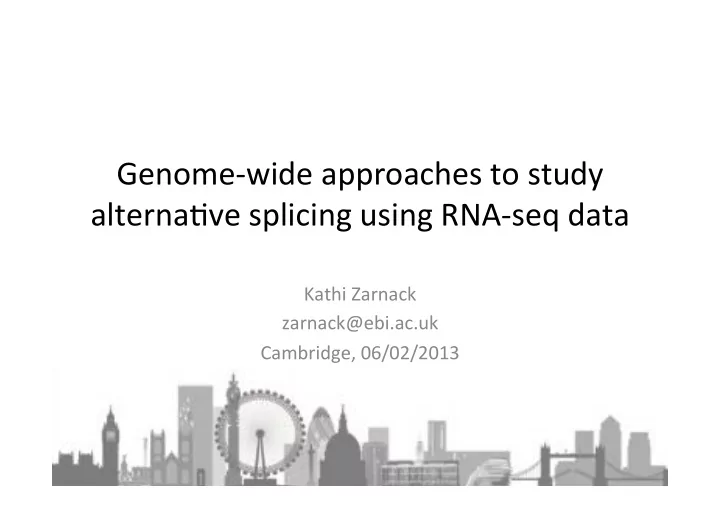

Genome-‑wide ¡approaches ¡to ¡study ¡ alterna5ve ¡splicing ¡using ¡RNA-‑seq ¡data ¡ Kathi ¡Zarnack ¡ zarnack@ebi.ac.uk ¡ Cambridge, ¡06/02/2013 ¡
Introducing ¡myself ¡ postdoc ¡at ¡the ¡CRUK ¡London ¡Research ¡Ins5tute ¡in ¡the ¡group ¡of ¡ Prof. ¡Nick ¡Luscombe ¡( hPp://www.luscombelab.org ) ¡ ¡ ¡ ¡ PhD ¡in ¡ Molecular ¡Microbiology ¡ switch ¡to ¡ Bioinforma8cs ¡for ¡my ¡postdoc ¡ ¡ interested ¡in ¡ pos:ranscrip8onal ¡regula8on ¡and ¡the ¡ac5on ¡of ¡ RNA-‑binding ¡proteins ¡
Outline ¡of ¡this ¡lecture ¡ • Introduc5on: ¡ – Alterna5ve ¡splicing ¡(AS) ¡ – Global ¡iden5fica5on ¡of ¡AS ¡events ¡ • Focus ¡of ¡this ¡Review: ¡ – Major ¡challenges ¡ – Different ¡approaches ¡to ¡extract ¡AS ¡ events ¡from ¡RNA-‑seq ¡data ¡ – Applica5ons ¡ • Conclusions ¡ ¡
INTRODUCTION ¡I ¡ Alterna5ve ¡Splicing ¡(AS) ¡
The ¡complex ¡life ¡of ¡mRNA ¡ McKee ¡and ¡SIlver ¡(2007) ¡ Cell ¡Res ¡17, ¡581-‑90 ¡
Alterna5ve ¡splicing ¡(AS) ¡ Image ¡taken ¡from ¡hPp://as-‑alps.nagahama-‑i-‑bio.ac.jp/ ¡
Example ¡I: ¡Dscam ¡in ¡ Drosophila ¡ • ¡neuronal ¡cell-‑surface ¡receptor ¡ • ¡more ¡than ¡38,000 ¡different ¡isoforms ¡ • ¡homophilic ¡interac5ons ¡mediate ¡repulsion ¡of ¡axons ¡and ¡dendrites ¡ Zipursky ¡et ¡al. ¡(2006) ¡Trends ¡Biochem ¡Sci ¡10:581-‑8; ¡Hemani ¡and ¡Soller ¡(2012) ¡Biochem ¡Soc ¡Trans ¡40: ¡804-‑9 ¡
Example ¡2: ¡Developmental ¡switch ¡ Gabut ¡et ¡al. ¡(2011) ¡Cell ¡147, ¡132-‑146 ¡
Types ¡of ¡alterna5ve ¡splicing ¡events ¡ Cassette exon Mutually exclusive exons Retained intron Alternative 5’splice sites Alternative 3’splice sites Alternative promoters Alternative poly-A sites Picture ¡taken ¡from ¡Lu ¡et ¡al. ¡(2011) ¡Handbook ¡on ¡Sta5s5cal ¡Bioinforma5cs, ¡Springer ¡Verlag ¡Berlin ¡Heidelberg ¡
The ¡regula5on ¡of ¡AS ¡events ¡ spliceosome ¡ large ¡ribonucleoprotein ¡complexes ¡ a ¡mul5tude ¡of ¡addi5onal ¡ (U1/U2/U4-‑U5-‑U6 ¡snRNPs) ¡ trans -‑ac5ng ¡ splicing ¡regulators ¡ interplay ¡determines ¡the ¡ splicing ¡decision ¡ at ¡each ¡individual ¡exon ¡ Chen ¡and ¡Manley ¡(2009) ¡Nat ¡Rev ¡Mol ¡Cell ¡Biol ¡10, ¡741-‑54 ¡
Misregula5on ¡in ¡disease ¡ A ¡large ¡number ¡of ¡disease ¡are ¡associated ¡with ¡muta5ons ¡ in ¡RNA-‑binding ¡proteins ¡ ¡ -‑ ¡FMRP ¡(Fragile ¡X ¡Mental ¡Retarda5on ¡Protein; ¡associated ¡ with ¡Fragile ¡X ¡Syndrome) ¡ -‑ ¡SMN ¡(Survival ¡Motor ¡Neuron ¡Protein; ¡mutated ¡in ¡Spinal ¡ Muscular ¡Atrophy) ¡ -‑ ¡TDP-‑43 ¡(associated ¡with ¡familial ¡form ¡of ¡Amyotrophic ¡ Lateral ¡Sclerosis) ¡ -‑ ¡FUS ¡(Fused ¡in ¡Sarcoma; ¡associated ¡also ¡with ¡ALS ¡and ¡ FTLD) ¡
AS ¡as ¡therapeu5c ¡targets ¡ Singh ¡and ¡Cooper ¡(20012) ¡Trends ¡Mol ¡Med ¡18, ¡472-‑82. ¡
INTRODUCTION ¡II ¡ Global ¡iden5fica5on ¡of ¡AS ¡ events ¡
Expressed ¡sequence ¡tags ¡(ESTs) ¡ • ¡cloning ¡and ¡sequencing ¡of ¡large ¡cDNA ¡fragments ¡(300-‑400 ¡nt) ¡ • ¡genomic ¡alignment ¡with ¡special ¡tools, ¡eg. ¡BLAT 1 ¡(BLAST-‑like ¡ Alignment ¡Tool) ¡ • ¡some ¡aligner ¡take ¡into ¡consider ¡consensus ¡splice ¡sites, ¡eg. ¡ GMAP 2 ¡ 1 Kent ¡(2002) ¡Genome ¡Res ¡12: ¡656-‑64. ¡ 2 Wu ¡and ¡Watanabe ¡(2005) ¡Bioinforma5cs ¡21: ¡1859-‑75. ¡
Microarrays ¡ Splice-‑junc8on ¡arrays ¡ Exon ¡arrays ¡ reciprocal ¡behaviour ¡of ¡probes ¡ reciprocal ¡behaviour ¡of ¡probes ¡ that ¡measure ¡inclusion ¡and ¡ that ¡measure ¡inclusion ¡and ¡ exclusion ¡of ¡the ¡exon ¡ exclusion ¡of ¡the ¡exon ¡
High-‑throughput ¡RNA ¡sequencing ¡ Image ¡taken ¡from ¡cmb.molgen.mpg.de ¡
Different ¡types ¡of ¡RNA-‑seq ¡ Different ¡sequencing ¡technologies: ¡ • ¡ ¡varying ¡read ¡lengths ¡ • ¡ ¡different ¡error ¡rates ¡ Illumina ¡HiSeq ¡ Different ¡experimental ¡protocols: ¡ stranded ¡vs. ¡unstranded ¡libraries ¡ • single-‑end ¡(SE) ¡vs. ¡paired-‑end ¡(PE) ¡ • ABI ¡DNA ¡Analyzer ¡
FOCUS ¡OF ¡THIS ¡REVIEW ¡
Focus ¡of ¡this ¡review ¡ “In ¡theory, ¡RNA-‑seq ¡can ¡be ¡used ¡to ¡build ¡a ¡complete ¡map ¡of ¡the ¡ transcriptome ¡across ¡all ¡cell ¡types, ¡pertuba5ons ¡and ¡states. ¡To ¡fully ¡realize ¡ this ¡goal, ¡however, ¡RNA-‑seq ¡requires ¡powerful ¡computa5onal ¡tools.” ¡ Garber ¡et ¡al. ¡(2011) ¡Computa5onal ¡methods ¡for ¡transcriptome ¡annota5on ¡and ¡quan5fica5on ¡ using ¡RNA-‑seq. ¡Nat ¡Methods ¡8: ¡469-‑77. ¡ Here, ¡I ¡will ¡review ¡computa5onal ¡approaches ¡to ¡extract ¡ alterna5ve ¡splicing ¡informa5on ¡from ¡RNA-‑seq ¡data. ¡ In ¡par5cular, ¡I ¡will ¡ • ¡explain ¡the ¡ major ¡challenges ¡ • ¡introduce ¡the ¡ different ¡solu8ons ¡and ¡how ¡they ¡were ¡ implemented ¡in ¡various ¡ available ¡tools ¡ • ¡discuss ¡their ¡ benefits ¡for ¡addressing ¡different ¡biological ¡ ques5ons ¡ ¡ ¡
The ¡goal ¡ 1. Genomic ¡alignment ¡ (con5nuous ¡or ¡splice-‑aware) ¡ 2. Transcript ¡reconstruc5on ¡ ¡ ¡ ¡ ¡ ¡ ¡ ¡ (or ¡use ¡known ¡annota5on) ¡ 3. Quan5fica5on ¡ ¡ ¡ ¡ ¡ ¡ ¡ ¡ ¡ ¡ ¡ ¡ ¡ ¡ ¡ ¡ ¡ ¡ ¡ ¡ ¡ (gene-‑level ¡or ¡transcript-‑level) ¡ Haas ¡and ¡Zody ¡(2010) ¡Nat ¡Biotechnol ¡28: ¡421-‑3 ¡
Genomic ¡alignment ¡ Splice-‑aware ¡alignment ¡tools: ¡TopHat 1 , ¡SpliceMap 2 , ¡GSNAP 3 , ¡QPALMA 4 ¡ 1 Wang ¡et ¡al. ¡(2008) ¡Nature ¡456: ¡470-‑6; ¡ ¡ 3 Robertson ¡et ¡al. ¡(2010) ¡Nat ¡Methods ¡7: ¡909-‑12. ¡ 2 Wu ¡and ¡Nacu ¡(2010) ¡Bioinforma5cs ¡26: ¡873-‑81. ¡ 4 Birol ¡et ¡al. ¡(2009) ¡Bioinforma5cs ¡25: ¡2872-‑77. ¡
Transcript ¡reconstruc5on ¡ Cufflinks 1 : ¡minimal ¡set ¡of ¡ compa5ble ¡isoforms ¡(maximum ¡ precision) ¡ ¡ Scripture 2 : ¡all ¡isoforms ¡that ¡are ¡ compa5ble ¡with ¡the ¡read ¡data ¡ (maximum ¡sensi5vity) ¡ 1 Trapnell ¡et ¡al. ¡(2010) ¡Nat ¡Biotechnol ¡28: ¡511-‑15 ¡ 2 GuPman ¡et ¡al. ¡(2010) ¡Nat ¡Biotechnol ¡28: ¡503-‑10 ¡
Novel ¡transcript ¡structures ¡ GuPman ¡et ¡al. ¡(2010) ¡ Nat ¡Biotechnol ¡28: ¡503-‑10 ¡
Quan5fying ¡transcript ¡abundance ¡ Challenges: ¡ 1. millions ¡of ¡reads ¡ 2. most ¡reads ¡cannot ¡be ¡mapped ¡unequivocally ¡to ¡a ¡single ¡ transcript ¡isoform ¡ 3. discriminate ¡gene-‑level ¡from ¡transcript-‑level ¡changes ¡in ¡ expression ¡ 4. exon-‑centric ¡vs. ¡transcript-‑centric ¡view ¡of ¡alterna5ve ¡splicing ¡
DIFFERENT ¡APPROACHES ¡
Recommend
More recommend